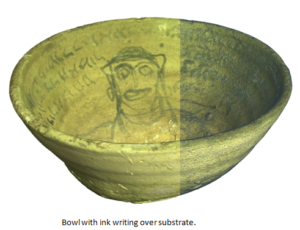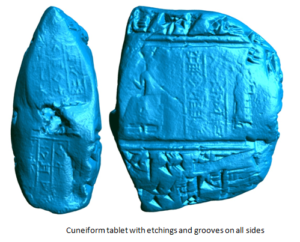SITUATION
 Collectors of artifacts and other archeological finds know that the stewardship and preservation of their finds are just as important as finding them at all. While the science of restoration is always improving, the chemical processes that cause corrosion and deterioration of physical parts is unavoidable and oftentimes accelerated once an artifact is unearthed. The Museum of the Bible, a nonprofit museum in Washington, D.C., acquired their first biblical artifact in 2009, and since then has grown to a collection of more than 40,000 objects, including clay tablets, pottery, papyrus, and other manuscripts. The Museum has investigated the use of modern 3D scanning technologies to not only digitally archive their collection, ensuring they would be preserved for future generations, but also to obtain surface measurement data to better analyze their collection and reveal hidden layers to these artifacts.
Collectors of artifacts and other archeological finds know that the stewardship and preservation of their finds are just as important as finding them at all. While the science of restoration is always improving, the chemical processes that cause corrosion and deterioration of physical parts is unavoidable and oftentimes accelerated once an artifact is unearthed. The Museum of the Bible, a nonprofit museum in Washington, D.C., acquired their first biblical artifact in 2009, and since then has grown to a collection of more than 40,000 objects, including clay tablets, pottery, papyrus, and other manuscripts. The Museum has investigated the use of modern 3D scanning technologies to not only digitally archive their collection, ensuring they would be preserved for future generations, but also to obtain surface measurement data to better analyze their collection and reveal hidden layers to these artifacts.
SOLUTION
Heather Reichstadt, Curator of Antiquities at the Museum visited Laser Design and brought with her a cuneiform tablet from roughly 2000 BCE and an inscribed bowl that originated in ancient Mesopotamia around 1500 years ago. The tablet was used for record keeping and contained fine etchings and grooves, whereas the bowl was used for rituals and contained ink writing on the inside but contained no fine etchings or grooves. Standard digital photography was limiting for the research needs and operations of the museum. Laser Design used the Artec Spider to perform high resolution 3D scans of each artifact, capturing the extremely fine markings and details, as well as the color/texture. The Artec Spider was ideal due to its ability to perform a non-contact scan at a very high detail without the use of contact probes, as well as its ability to collect color information. Another benefit of the Artec Spider is its portability, which would be important for the museum to scale up its 3D scanning operations. The raw scan data was processed in Artec Studio software and exported to a high resolution, colorized mesh model which can be used for downstream visualization and measurement.
 RESULTS
RESULTS
Laser Design’s 3D Scanning Lab used Artec Studio software to produce 3D models that accurately match the size, shape, and color information of each part. The cuneiform tablet scan data, once loaded into a 3D rendering program, revealed fine details that were not known before. For the bowl, the color data captured by the Spider yielded a nearly perfect digital replica of the writings. For both parts, custom software lighting schemes would further expose details that could not have been seen in the physical world as interfering color information is digitally stripped away. As an added benefit of 3D scanning, the 3D scan yielded a baseline shape that can then be used to compare future scans of the same part against in order to quantify and inform potential restoration needs with greater precision than referencing standard photographic archives. The Museum can now appreciate the benefit of 3D scanning and will look to incorporate this technology in digitizing their collection.
ABOUT MUSEUM OF THE BIBLE
The museum in Washington, D.C. will be housed in a 430,000-square-foot building just two blocks from the National Mall and three blocks from the nation’s Capital, and it will open in the fall of 2017. It will provide guests with an immersive and personalized experience as they explore the history, narrative, and impact of the Bible.
The Museum of the Bible will be an unparalleled experience, using cutting-edge technology to bring the Bible to life. It will span time, space, and cultures, inviting everyone to engage with the Bible. With three permanent sections and space for temporary exhibits, there will always be something new to explore.
